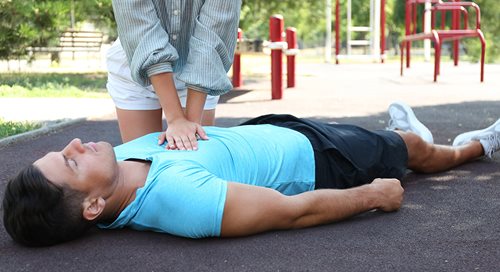Many people across the nation were moved by the heroic actions when Buffalo Bills safety Damar Hamlin went into cardiac arrest during a Monday Night Football game. Because one trainer immediately began CPR (cardiopulmonary resuscitation) on the field, Hamlin is out of the hospital and alive today.
 The incident left many asking themselves, “Would I be able to help someone in a similar situation?”
The incident left many asking themselves, “Would I be able to help someone in a similar situation?”
Know the signs of cardiac arrest
Amy Campbell, a registered nurse in the Community Regional Medical Center emergency department, shares, “If you see a person collapse or just slump down, or (they’re) just unresponsive, you maybe want to provide them a quick shake like, ‘Hey, are you awake?’”
Signs of cardiac arrest may include:
Being unresponsive
No pulse or heartbeat
Not breathing, or gasping for breath
If you don’t get an immediate response, Campbell says, “Always activate the 9-1-1 system if you are out in the general public. Look to see if they are breathing and if not, you can feel for a carotid pulse.”
The carotid artery is easy to find on the side of the neck just under the jaw bone. “If you do not feel a carotid pulse for ten seconds then you go ahead and start compressions on the chest,” Campbell adds.
How CPR works during cardiac arrest
CPR can double or even triple the chances of someone surviving cardiac arrest.
When your heart stops beating, the blood bringing necessary oxygen to your brain and the rest of your organs stops circulating. During CPR, repetitive pressure is applied to the heart to help restore blood flow to the most vital organs in the body. In short, you're acting as the heart to keep blood flowing.
For someone who’s experiencing cardiac arrest, the longer they go without CPR, the more likely they will suffer from long-term consequences or even death.
How to learn CPR
Every year, between 300,000 and 475,000 people die from cardiac arrest in the United States, according to the National Heart, Lung and Blood Institute. It’s important to know how to administer CPR correctly to avoid injuries and be more effective.
Campbell adds, “There’s research that shows the chances of surviving a heart attack or respiratory arrest are greater if someone on the scene knows CPR.”
If you don’t know how to do full CPR, you can provide “hands-only CPR” while waiting for emergency responders:
Lock your arms and push hard and fast in the center of the chest to help achieve a rate of 100 to 120 beats per minute. Sing the song “Stayin’ Alive” by the Bee Gees. It can help you keep a steady beat and is recommended by the American Heart Association.
If you can take a class, even better. CPR classes are offered by many organizations in the community, including the American Red Cross.
Anyone can be trained on how to use this life-saving skill. Learning CPR can give you the confidence you need to help save the life of a friend, family, co-worker or stranger.


.jpg?language=en-US)


